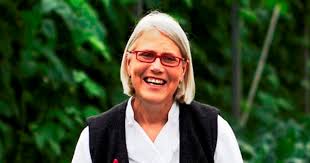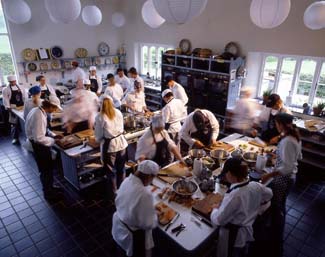The Darina Allen Column

This month Darina talks about the myth that low fat is good for you - and why we need fat in our diet. So why not resolve to begin the new year with a better diet, enriched by food with plenty of good fats - including whole milk, cream and butter - on the menu.
I rarely shop in a supermarket, I know this sounds quite extraordinary but I live in the country, in the middle of a farm and we grow a lot of our own food. I’m also a big advocate of Farmers’ Markets and small independent local shops so my reality is kinda different.
It can be months between one visit to a supermarket and the next – having said that I love a wander around Fields in Skibbereen when I’m in West Cork, a large supermarket which still manages to keep the local shop feel and one of the few (Scally’s in Clonakilty is another) that goes out of its way to source and support local farmers, food producers and fishermen.
Hadn’t been for a while and was in search of a pound of butter to make some hollandaise sauce to embellish a fine fresh hake that I had just bought in the Skibbereen Farmers Market.
At first I thought there was no butter but eventually I found some Kerrygold and Aughadown from Drinagh Co-Op at the very end of a long run of every conceivable spread. I had passed yards and yards of dairy products, mostly, light, low fat, no fat...
What IS going on? Surely people know by now, that pure natural butter is good for us and that other edible ‘food like substances’ predominately made in laboratories are most definitely not. The myth that low fat is good for you was the biggest con of the late 20th and 21st century. That theory and false science has been thoroughly discredited.
If you only remember one thing from this article, it ought to be the following fact. We need good fat in our diet to help the body to absorb the nutrients from other foods. Only two Vitamins, B and C are water soluble, all the others are fat soluble – so what does that mean?
Unless we have some fat in our diet, we cannot extract maximum nutrition from what we eat… So that’s just one of the many reasons why low fat is detrimental to our health and why ‘surprise, surprise’, people who were put on a totally low-fat diet were found to be suffering from malnutrition, yes malnutrition after a few months. The fat doesn’t have to be butter, it can be extra virgin olive oil, lard or beef dripping but it must be a good fat, pure and preferably organic.
If you don’t believe me, do your own research and see how ever since the Keys 1961 report followed by The Dietary Goals for the United States encouraged Americans to eat less high fat red meat, eggs and dairy and replace them with more calories from fruits, vegetables and especially carbohydrates.
First in the US and then everyone else seems to follow suit without ever checking their science. So for four decades, our governments, department of health, dieticians and doctors (who by the way have virtually no training in nutrition) have repeated the same dogma over and over again.
It wasn’t until 2014 when the result of the meta analysis of over 80 scientific papers and research documents that we learned that there wasn’t a shred of evidence to link butter and saturated fats to cardiovascular disease, fancy that...
Meanwhile, a multi-billion dollar/euro/pound industry has been developed on the back of this false science. But the most serious element is that by now the general public have been so brainwashed into thinking that fat of any kind is public enemy No 1 that they actually can’t face it.
Desperately serious for our health. Babies and small children need lots of good fat for their brain development. It’s connected to fertility, to our energy level, concentration...
Lest there be any misunderstanding, it’s not the fault of the supermarkets, they will sell what the public want... So don’t be conned, eliminate those low-fat products totally from your diet. Mother Nature did not put fat on meat and fish to annoy us, it’s there so we can absorb the maximum benefit from the lean meat. See Weston A Price Foundation - www.westonaprice.org
RECIPES
Baked Flat Fish on the Bone with Herb Butter
This is a very simple ‘master recipe’ is ideal for plaice and sole and can be used for all very fresh flat fish, e.g. brill, turbot, dabs, flounder and lemon sole. Depending on the size of the fish, it can be a starter or a main course. Because it is cooked on the bone the flavour is superb. It is also delicious with Hollandaise Sauce, Mousseline or Beurre Blanc.
Serves 4
4 very fresh plaice or sole on the bone
Herb Butter
2-4 oz (50-110g) butter
4 teaspoons mixed finely-chopped fresh parsley, chives, fennel and thyme leaves
salt and freshly ground pepper
Preheat the oven to 190°C/375°F/gas mark 5.
Turn the fish on its side and remove the head. Wash the fish and clean the slit very thoroughly. With a sharp knife, cut through the skin right round the fish, just where the 'fringe' meets the flesh. Be careful to cut neatly and to cross the side cuts at the tail or it will be difficult to remove the skin later on.
Sprinkle the fish with salt and freshly-ground pepper and lay them in 1cm (1/2 inch) of water in a shallow baking tin. Bake in a moderately hot oven for 20-30 minutes according to the size of the fish. The water should have just evaporated as the fish is cooked.
Check to see whether the fish is cooked by lifting the flesh from the bone at the head; it should lift off the bone easily and be quite white with no trace of pink.
Meanwhile, melt the butter and stir in the freshly-chopped herbs. Just before serving catch the skin down near the tail and pull it off gently (the skin will tear badly if not properly cut). Lift the fish onto hot plates and spoon the herb butter over them. Serve immediately.
Old-Fashioned Rice Pudding with softly whipped cream and soft brown sugar
A creamy rice pudding is one of the greatest treats on a cold winter’s day. Make it with whole milk and you’ll need to use short-grain rice which plumps up as it cooks. This is definitely a forgotten pudding and it’s unbelievable the reaction we get to it every time we make it at the Cookery School. It’s always the absolute favourite pudding at my evening courses.
Serves 6–8
100g (3½ oz) pearl rice (short-grain rice)
40g (1½ oz) sugar
small knob of butter
850ml (1½ pints) whole milk
Softly whipped cream and soft brown sugar to serve.
1 x 1. 2 litre (2 pint) capacity pie dish
Preheat the oven to 180ºC/350ºF/Gas Mark 4.
Put the rice, sugar and butter into a pie dish. Bring the milk to the boil and pour over. Bake for 1–1½ hours. The skin should be golden, the rice underneath should be cooked through and have soaked up the milk, but still be soft and creamy.
Calculate the time it so that it’s ready for pudding. If it has to wait in the oven for ages it will be dry and dull and you’ll wonder why you bothered.
Serve with the softly whipped cream and soft brown sugar.
---
'30 Years at Ballymaloe' - Bord Gáis Avonmore Cookbook of the Year 2013
Good Food Ireland Cookery School of the Year 2012/2013
***
 Once again, the Ballymaloe Cookery School in East Cork has a great programme of cookery courses for all interests and abilities running throughout 2018. Ranging from a relaxing visit to sit in on an afternoon cookery demonstration to a week long ‘Intensive Introductory Course’.
Once again, the Ballymaloe Cookery School in East Cork has a great programme of cookery courses for all interests and abilities running throughout 2018. Ranging from a relaxing visit to sit in on an afternoon cookery demonstration to a week long ‘Intensive Introductory Course’.
Sitting in the middle of a 100 acre organic farm the Ballymaloe Cookery School provides its students not only with a life skill learnt under the expert tutelage of their very capable teachers but also a place to relax and unwind from the stresses and strains of normal everyday life. The cottage accommodation available onsite for residential courses consists of a collection of delightful converted outbuildings which have been transformed over the years by the Allens, and other accommodation is available locally for the short courses.
www.cookingisfun.ie






There are currently no comments
Leave a comment
Not a member? Register for your free membership now!
Or leave a comment by logging in with: